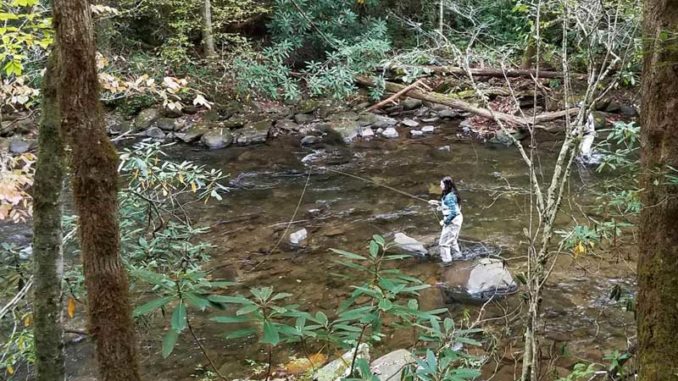
Trout anglers know no calendar
Don’t overlook winter trout. Die‑hard trout fishers don’t pay attention to the calendar or the weather, because trout fishing is a year-round, any-kind-of weather activity. Plus, dedicated anglers know that the mere act of fishing can be as satisfying as catching fish. As Ray Bergman says in Trout — the bible of American trout fishers — “I believe that fishing was simply an excuse to get out in the open, to breathe air that came to me directly over open spaces, and to face nature when she bared her soul.”
Bergman said some of his best fishing experiences were on cold, windy days when others stayed close to the warmth of the hearth. And that meant he had a trout stream to himself.
Trout, of course, aren’t as active in cold weather. Their metabolism slows. They don’t move as much, nor feed as often. Yet on those rare, winter days when the temperature rises and the sun breaks on a dreary, gray day, hatches come off, and when hatches come off, trout feed.
Bruce Hurang of Asheville, a founder of Smoky Mountain Fly Fishers, said the best times to fish in the winter are on sunny afternoons, from about noon to 3 or 4 p.m.
“I watch for midge and small black stone hatches,’’ he said. “And I fish the deep holes. That’s where you’ll find trout. The shallow areas are usually too cold.”
Hurang suggests working the bottom of a pool slowly and fishing it thoroughly, quartering and sectioning off areas. Sometimes, he said, “You have to put a nymph on a trout’s nose to get it to hit.”
Tailwater trout
Another good place to fish during cold weather months, Hurang said, is in tailwaters below dams. Most dams release water at the bottom. And water temperatures are constant, usually between 42 and 48 degrees.
Even on a “really rotten, cold and rainy day, you’ll find blue-winged olive hatches coming off,” he said. And when a hatch emerges, trout will feed.
For winter fishing, Hurang prefers olive, black and dark brown emerger patterns, small black stone wet flies and midges with dark wings.
Time, not location
Roger Lowe of Waynesville, a master fly tier and long-time guide, said, “The time of the day actually is more important than the pattern you use.”
Lowe suggests watching for temperature peaks, which usually occur around mid‑day and early afternoon.
For nymph fishing, Lowe recommends Secret Weapon, Woolly Bugger, Hare’s Ear, Pheasant Tail, Stone Fly and Zug Bug patterns. The secret to successful nymph fishing, Lowe said, is to get enough split shot on the line to get the nymph down so it will bump along the bottom. For smaller nymphs, he said, use a couple of split shots (B or BB). With a Woolly Bugger and other large nymphs, use five or six split shot, especially if the stream has a heavy current.
Trout congregate in bigger pools in cold weather, usually toward the middle, where they wait for food to come to them. During cold weather, Lowe suggests fishing larger streams, especially valley streams, such as the Oconaluftee, Tuckasegee, Nantahala and Watauga rivers, where water tends to be warmer. Streams with shaded banks are less productive because the water doesn’t warm up as quickly.
Ronnie Setzer of Sylva, a long-time fly fisher and guide, said a big advantage of winter fishing is that fish aren’t as easily spooked as they are in summer.
“You don’t have to throw long lines, and it’s much easier to keep out of a trout’s vision,” he said.
Winter wild trout
Winter is a particularly good time to fish wild trout streams, Setzer said. Trout are more concentrated, and you don’t have to cover as much water.
“I catch very few 4- and 5-inch trout in the winter,” he said. “Most of them are 7 inches and longer.”
According to Setzer, persistence is important for winter fishing.
“You may have to cast six or eight times in the same spot before you get a strike,” he said. “Sometimes, they won’t move more than a foot out of their regular feeding path.”
One disadvantage of winter fishing is a shorter period of daylight, especially with Daylight Savings Time no longer in effect. Prime winter fishing hours are between 10:30 a.m. and 4:30 p.m. If you’re on a stream after 4:30 p.m., you’ll more than likely walk to your vehicle in the dark.
Delayed-harvest streams offer exceptional fishing during the winter. Streams were generously stocked in early October and again the first week in November.
Even when the weather is cold and wet, trout fishing is always a fine wintertime escape, and it certainly beats sitting in front of the TV.





Be the first to comment